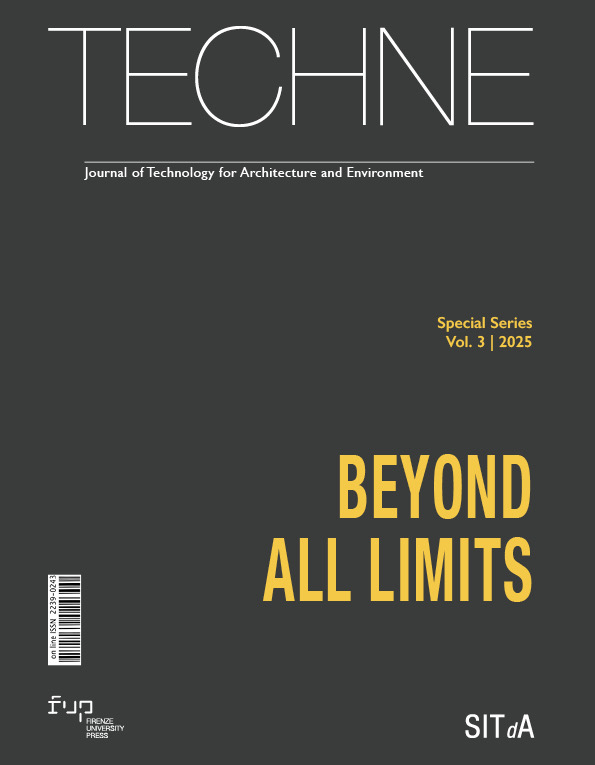Published 2025-07-31
Keywords
- identity,
- natural pathways,
- psychophysical well-being,
- amalfi coast,
- interlaced arches
How to Cite
Copyright (c) 2025 Rosina Iaderosa, Ornella Zerlenga, Margherita Cicala

This work is licensed under a Creative Commons Attribution 4.0 International License.
Abstract
This research investigates innovative strategies and presents experimental insights to enhance cultural and landscape identity through the integrated design of naturalistic paths and digital tools, such as UAS and Virtual Tours. The objective is to develop a holistic model of cultural engagement that combines on-site physical experiences, immersion in nature and in-depth knowledge acquisition. Particular attention is given to the exploration of distinctive decorative elements, such as ornamental motifs found on elevated architectural structures which are often difficult to access. The proposed model, exemplified through its application to the Amalfi Coast, serves as an adaptable framework for the sustainable valorization of other territorial contexts with similar landscape and cultural characteristics.
Downloads
References
- Bradley, M.C. (2018), The Joy of Forest Bathing: Reconnect with Wild Places & Rejuvenate Your Life, Rock Point, New York.
- Cantizani-Oliva, J., Reinoso-Gorbo, J. and Gamiz-Gorbo, A. (2023), “Proportions and Deformations in the Mosque-Cathedral of Cordoba”, Nexus Netw J, Vol. 25, pp. 145–165. Available at: https://doi.org/10.1007/s00004-022-00622-y (Accessed on 10/02/2025). DOI: https://doi.org/10.1007/s00004-022-00622-y
- Clévenot, D. and Degeorge, G. (2000), Decorazione e architettura dell’Islam, Le Lettere, Firenze.
- Felber, U. (2020), Il bagno nella foresta, Il punto d’Incontro, Vicenza.
- Galasso, F. and La Placa, S. (2020), “Comparative data processing methods: analysis and considerations on photogrammetric outputs obtained from UAV. The case study of the facade of the Church of the Certosa di Pavia”, in Barba, S., Parrinello, S., Limongiello, M. and Dell’Amico, A. (Eds.), Drones. Systems of Information on culTural hEritage. For a spatial and social investigation, Pavia UniversityPress, Pavia, pp. 208-217.
- Gámiz-Gordo, A., Cantizani-Oliva, J. and Reinoso-Gordo, J. F. (2021), “The Mosque-Cathedral of Cordoba: Graphic Analysis of Interior Perspectives by Girault de Prangey around 1839”, ISPRS International Journal of Geo-Information, Vol.10, n. 3, p. 181. Available at: https://doi.org/10.3390/ijgi10030181 (Accessed on 10/02/2025). DOI: https://doi.org/10.3390/ijgi10030181
- Kaplan, R. and Kaplan, S. (1989), The experience of nature: A psychological perspective, the Press Syndicate of the University of Cambridge, New York.
- Louv, R. (2005), Last Child in the Woods: Saving Our Children from Nature-Deficit Disorder, Algonquin Books of Chapel Hill, Chapel Hill.
- Lumber, R., Richardson, M. and Sheffield, D. (2017), “Beyond knowing nature: Contact, emotion, compassion, meaning, and beauty are pathways to nature connection”, PLOS ONE, Vol. 12, n. 5. Available at: https://doi.org/10.1371/journal.pone.0177186 (Accessed on 10/02/2025). DOI: https://doi.org/10.1371/journal.pone.0177186
- Migliari, R. (2003), Geometria dei modelli. Rappresentazione grafica e informatica per l’architettura e per il design. Kappa, Roma.
- Richardson, M., Hallam, J. and Lumber, R. (2015), “One thousand good things in nature: The aspects of nature that lead to increased nature connectedness”, Environmental Values, Vol. 24, n.5, pp. 603-619. Available at: https://doi.org/10.3197/096327115X14384223590131 (Accessed on 10/02/2025). DOI: https://doi.org/10.3197/096327115X14384223590131
- Sgrosso, A. (1996), La rappresentazione geometrica dell’architettura. Applicazioni di geometria descrittiva. Utet Università, Torino.
- Weyl, H. (1962), La Simmetria, Giangiacomo Feltrinelli Editore, Milano.
- Wilson, E.O. (1984), Biophilia, Harvard University Press, Cambridge. DOI: https://doi.org/10.4159/9780674045231
- Yoshifumi, M. (2018), Shinrin-yoku. La teoria giapponese del bagno nella foresta per ritrovare il proprio equilibrio, Gribaudo, Milano.
- Zerlenga, O., Cicala M. and Iaderosa R., (2022), “Intrecci amalfitani. Decorazioni fra contaminazioni egeometrie”, in Cicalò, E., Savini, F. and Trizio, I. (Eds.), Linguaggi Grafici. DECORAZIONE, PUBLICA, Alghero, pp. 120-147.
- Zerlenga, O. (2008), Rappresentazione geometrica e gestione infografica dei modelli. Disegno ornamentale_Intersezione di superfici, La scuola di Pitagora editrice, Napoli.
- Zerlenga, O. (2006), “Costiera amalfitana. Segni e disegni della contaminazione”, in Gambardella, C. and Martusciello, S. (Eds.), Le Vie dei Mercanti. Disegno come topologia della mente. Terzo Forum Internazionale di Studi ‘Le Vie dei Mercanti’. Relazioni, Alinea Editrice, Firenze, pp. 309-317.






